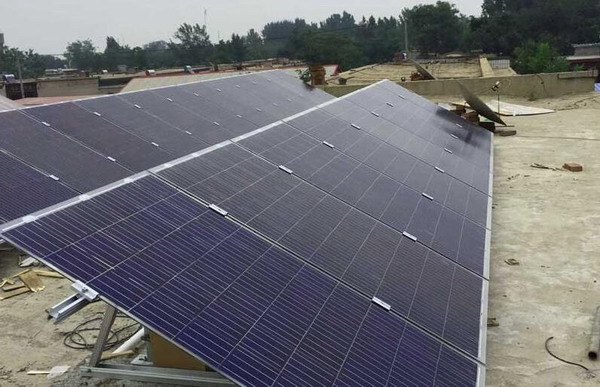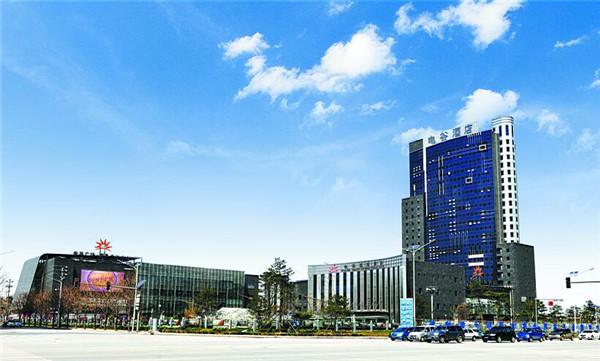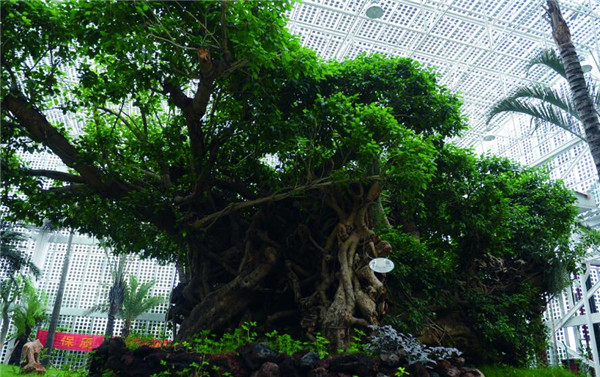
Yingli established a distributed corporation in accordance with the demands of PV market. In November 2013, it popularized photovoltaic products for family use via CCTV platform, and became the first enterprises which proposed household distributed concept in China, launched and installed "golden sheep" household distributed system to promote village-level power stations and promote solar energy and the concept of environmental protection to the home of ordinary people.

Household distribution has bright market prospects. In 2016, Yingli officially launched the household photovoltaic system brand Innergy. It guided the public to correctly recognize the photovoltaic system, and led the sound development of the industry by providing high-quality products and services. Take 5 KW household photovoltaic system for example, the system can generate 135,000 kWh power within its 25 service life, which is equal to the reduction of the emission of 56 tons of fire coal, 140 tons of carbon dioxide and 0.92 tons of sulfur dioxide.
Portuguese Maola Project was implemented under the cooperation of Yingli and Spanish Acciona Energy Corporation, and connected and combined and completed by the end of 2008. Covering an area of 320 acres, the project consists of 2,500 monomer tracking systems, with each piece of tracking system of about 17,000 watt and total installed capacity of 46 MW, which was the largest crystalline silicon power plant in the world at that time. The project has an annual generating capacity of 55.20 million kWh. Compared with traditional thermal power, every year it can save about 16,330 tons of standard coal and can reduce about 44,000 tons of carbon dioxide emissions and around 398 tons of sulfur dioxide. This project has become a demonstration spot for popularizing PV knowledge for local primary schools, which is often visited by students and trains the PV green energy concept of locals since they were young.
Guangdong Yingli Liannan 50 MW PV Power Generation Project of Ecological Agriculture installed solar panels on idle barren land, planted crops under the panels, which neglects neither power generation nor planting and uses the land for multiple purpose and also adds value to the land. This project is the first demonstration project of photovoltaic agriculture ecology in Northern Guangdong, with a total investment of the project of about 150 million Yuan and covering an area of about 556 mu. When its annual average generating capacity is 20 million KW, every year the project can save 6,630 tons of standard coal and reduce the emissions of 18,167 tons of carbon dioxide, 123 tons of sulfur dioxide, 60.6 tons of nitrogen oxide, and 40 tons of carbon dust.


Besides, Yingli has proactively explored new forms of photovoltaic applications with its partners, provided photovoltaic and diesel hybrid irrigation system with the Australian partner Solar Pumping Solutions for local farmers, and provided remote monitoring module and switching function under different irradiances, which facilitated that the local 100KW photovoltaic farm irrigation system got an annual generating capacity of 53,000 kWh and reduced 60% of its diesel consumption.

On January 29, 2016, the opening ceremony of 20 MW fishery-PV complementation PV power generation project was hosted at Zhenshang Village, Qishui Town, Leizhou City. The project was located at the seaside shrimp pond in Zhenshang Village, Qishui Town, which covers an area of about 408 mu, with a total planned investment of 189 million Yuan and a construction cycle of 6 months. The project has an annual generating capacity of 24 million kWh. Compared with traditional thermal power, every year it can save about 7,100 tons of standard coal and can reduce about 19,000 tons of carbon dioxide emissions and around 173 tons of sulfur dioxide. Thus it can be seen that the project has remarkable economic benefits, social benefits and environmental benefits. Besides, it is also the first fishery-PV complementation demonstration project in Guangdong.
Covering an area of 250,000㎡, the project has an investment of 184 million Yuan and annual average generating capacity of over 23 million kWh. The annual reduced amount of carbon dioxide emission is equal to planting 10,000 trees, which has contribute greatly to energy conservation and emission reduction and the elimination of smog. The power station has adopted the principle of nearest grid and nearest utilization, and its power generated is incorporated into 10KV and 400V low pressure side and directly supplied to Panzhihua Iron & Steel for its consumption, 100% self-generated for own consumption. It has provided Panzhihua Iron & Steel with green and pollution-free energy and also built up its image of energy conservation and environmental protection.
Located at DuPont Shanghai Factory Area, this project has a total installed capacity of 221.4 KW, a total investment of about RMB 1.48 million Yuan and monthly generating capacity of about 18,000 kWh, mostly self-generated for own consumption and redundant power during festivals and holidays (about 65 days) are sold to local grid company. The project can provide clean green power for 25 consecutive years without interruption, which is a wise move to promote the sustainable development of enterprises and practice corporate social responsibility.
This project can provide about 5.5 million kWh of clean power within 25 years, which is equal to planting 44,000 mu trees and reducing 5,000 tons of carbon dioxide emissions.
Located in the roof of the factory area of Great Wall Motor Co., Ltd., this project was completed in 2013, with an installed capacity of 50 MW, which was “Golden Sun” monomer project with the largest installed capacity in Hebei built by Great Wall Motor and the photovoltaic enterprise Yingli together. The project has a total installation area of 400,000㎡ and will have an annual generating capacity of 62 million kWh after being completed. Every year it can save 24,800 tons of standard coal and can reduce 64,480 tons of carbon dioxide emissions. The project has significant economic benefits and good demonstration effects of energy conservation and emission reduction.
In 2013, 20MW Golden Sun Project of the Great Wall Tianjin Branch all used Yingli’s products. The total installation area of the project reached 160,000㎡, the project will have an annual average generating capacity of 24.8 million kWh after being completed. And it will save 9,920 tons of standard coal every year and reduce 25,792 tons of carbon dioxide emissions every year.
Yingli provided the 5.8 MW panda components to the Jaguar Land Rover Engine Manufacturing Center in West Midlands, England, and connected the grid in March 2014, with about 30% of the annual electricity coming from the solar power plant. About 30% of the power that the manufacturing center saved every year is from solar power generation. Covering an area of 35,000㎡ roofs, this project can reduce 2,400 tons of carbon dioxide emissions, amounting to providing electricity to 1,600 families, is Britain's largest rooftop photovoltaic project. It reflects the same operation philosophy of sustainable development of Jaguar Land Rover and Yingli.
The Phase-1 500 mu demonstration project of the comprehensive management and development of 3,500 mu heavy metal contaminated soil of Renhua County, Guangdong invested to build a 20 MW photovoltaic power station in 2015, with a total investment of 190 million Yuan for land pollution control. The Phase 1 20 MW PV project has an annual generating capacity of about 23 million kWh power, can save 7,400 tons /year of fuel coal, reduce carbon dioxide emissions by 22,400 tons /year, reduce sulfur dioxide emissions by 678 tons /year, reduce nitrogen oxide emissions by 339 tons /year, and reduce dust emissions by 6,100 tons /year, which will alleviate environmental pollution of China.
The effective integration of soil restoration and PV power generation can chang some land that has lost the original function into useful land with ecological function and cultivation function, improve the utilization of the land, Besides, it has utilized the land polluted by heavy metal after the completion of the project, which has to some extend increased the area of effective cultivated land and alleviated the contradiction among the local people.
Because the power plant project will run for 25 years, it can ensure farmers to have a long-term source of income. According to the estimation, building a photovoltaic power station with 5,000 mu contaminated land will solve the survival of about 1,800 farmers. Meanwhile, it will create a large number of jobs, effectively increase the income of farmers, improve the quality of their life, improve the microclimate of farmland production, beautify the rural living environment, and comprehensively improve the rural production and living conditions.
In 2016, Xi'an Zhongda International 479kW Photovoltaic Air Conditioning Project officially started its combination to the grid and acceptance. It is understood that this is currently the largest photovoltaic air-conditioner project in China. “Photovoltaic air conditioner” can directly use air conditioning driven by photovoltaic direct current. In addition, the PV HVAC system can also be used as an inverter to convert the photovoltaic direct current into alternating current, which can be sold to State Grid Corporation of China under the condition that the power cannot be used up. Compared with traditional air-conditioner, photovoltaic air-conditioner not only saves the cost, but receives state subsidies and contributes to environmental protection.
At present, the system can generate more than 1,400 kWh per day, with annual generating capacity of over 50,000 kWh, and can receive subsidies of more than 200,000 Yuan. Besides, it also can save more than 400,000 Yuan of electric charge every year, so the economic benefits are very considerable; in addition to the substantial return on investment, the system can also reduce carbon dioxide emissions by nearly 500 tons per year, so the environmental benefits are also very significant.
In the course of its 30 years of development, Yingli has continuously improved energy efficiency through technological innovation, and effectively reduced greenhouse gas emissions and energy consumption. In order to further broaden the field of photovoltaic applications, Yingli has begun to BIPV research and development and project construction since 2005. Over the past ten-odd years, Yingli has set off and led to the trend of "lower-carbon" architecture through technological innovation, product iteration, model development, and standard setting. Eight generations of BIPV products witnessed the experience, technology and strength of Yingli in the field of BIPV construction.

Completed in 2010, the project, with photovoltaic grid connected capacity of 0.75MWp and grid connected installation area of 4,490m2, is China's first building integration demonstration project which has widely applied solar energy PV power generation from multiple angles. Yingli will install the self-developed and manufactured full-glass solar cell components on the outer wall and roof of the hotel and Power Valley Plaza to turn the entire building into a small power station. Since its connection to the grid, the project has had a total generating capacity of 1.82 million kWh, and can replace 728 tons of standard coal, reduce 1,890 tons of CO2 emissions, 19.6 tons of SO2 emissions, 9.8 tons of NOX emissions and 16.8 tons of soot emissions, and achieved the emission reduction benefits of 4.984 million Yuan. The hotel is not only unique in the function of solar power generation, but aso exemplary in the comprehensive utilization of energy. The entire hotel, including the heating and cooling of conference center, adopts sewage source heat pump technology, which exchanges energy via plate heat exchanger and extracts sewage temperature difference, and is used for heating, cooling and living water heating in buildings. The technology has realized the recycling of urban sewage and fully reflected the concept of “green, environmental protection and energy saving”.




Urban Low-carbon Park is a photovoltaic greenhouse demonstration project combining photovoltaic and leisure industry, which was completed in 2016 and covers an area of 48 mu, with a construction area of 31,968㎡. It is the largest photovoltaic greenhouse park in Asia and its 7 national patents of comprehensive utilization of energy have full independent intellectual property rights. The outer wall and roof all adopt double-glass panda solar cell modules independently developed and manufactured by Yingli. With the total installed capacity of 3 MW and annual generating capacity of 3.6 million kWh, the project can save 1,512.2 tons of standard coal and can reduce 3,714 tons of carbon dioxide emissions. Urban Low-carbon Park creates a leisure, health and green consumption pattern which is closer to people’s life, which is an innovation leading a new way of life.
In 2009, Yingli began to participate in promoting the Golden Sun Project. Since its undertaking of the pilot project in 2011, it has undertaken “PV power generation demonstration project of the central state organs” and installed photovoltaic components to the rooftop of the ministries and commissions, built demonstration projects for the Ministry of Industry and Information Technology, Ministry of Science and Technology, the Ministry of Human Resources and Social Security, and National Tourism Administration etc., with its total installed capacity in China of 9MW. This approach will pave the way for the large-scale promotion of solar energy by the national government organs in the future.
At the beginning of 2011, 4.4MW photovoltaic component project of Denver International Airport was completed. This project is the largest distributed photovoltaic power station in Colorado. It transmits about 7 million kWh clean powers to Denver International Airport every year and reduces 5,000 tons of carbon dioxide emissions. This project is the third large photovoltaic power station Denver International Airport, known as “green” airport. Yingli helped Denver International Airport expand its utilization of renewable energy and also provided a good example in promoting ‘green economy’, which made Denver International Airport become a paragon of sustainable development pattern.
In December 2013, the project of Antalya International Airport, Turkey built with Yingli’s component products was successfully connected to the grid. With an installed capacity of 250KW and annual generating capacity of 372,470 kWh, this project can reduce 115,838 kg of carbon dioxide emissions.
Yingli has carried out extensive international cooperation. It provided 5MW photovoltaic components for Singapore Nanyang Technological University, which was connected to the grid in the third quarter of 2015, had an annual capacity of 6 million kWh and reduced 3,100 tons of carbon dioxide emissions. This project is a part of the overall plan of low-carbon “mini city” of Nanyang Technological University, which will reduce about 1.5 million power charge expenditure for the University. It is the largest PV project in Singapore as of the end of 2015.